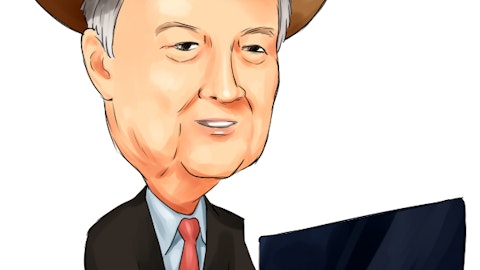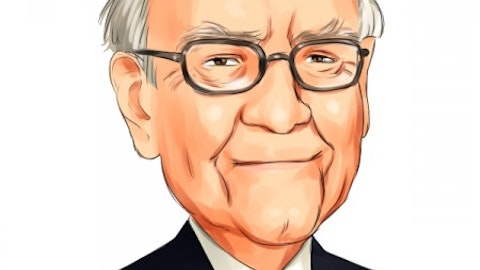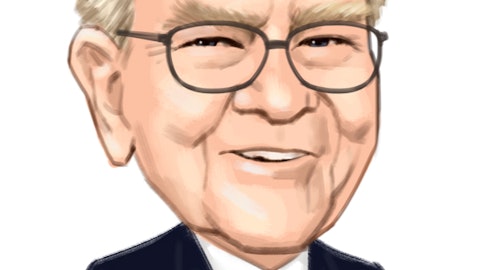Warren Buffett looks for great businesses trading at fair or better prices suitable for long-term holding.
“It’s far better to buy a wonderful company at a fair price than a fair company at a wonderful price.”
– Warren Buffett
What is a ‘wonderful company’?
It’s a business with a strong and durable competitive advantage.
“The key to investing is not assessing how much an industry is going to affect society, or how much it will grow, but rather determining the competitive advantage of any given company and, above all, the durability of that advantage.”
– Warren Buffett
Warren Buffett focuses on quality and the long-run. There’s an index filled with Buffett’s wonderful businesses. This Index makes finding high quality businesses easy.
The Index I’m referring to is the Dividend Aristocrats Index. The Dividend Aristocrats Index is comprised of 50 businesses with 25+ years of dividend payments without a reduction.
A business must have a strong and durable competitive advantage to pay increasing dividends for 25+ consecutive years.
Warren Buffett puts his money where his mouth is.
He has invested in 4 Dividend Aristocrats. This article takes a look at Warren Buffett’s 4 Dividend Aristocrat holdings.
Follow Warren Buffett's Berkshire Hathaway
#1 The Coca-Cola Co (NYSE:KO)
The Coca-Cola Co (NYSE:KO) announced a 6% dividend increase on February 18th. This is the 54th consecutive annual dividend increase for Coca-Cola. Coca-Cola’s dividend streak started when Lyndon B. Johnson was president…
The company’s long dividend streak puts it in especially rarefied air. Coca-Cola is one of only 17 Dividend Kings – dividend stocks with 50+ years of consecutive dividend increases.
When investors think about Coca-Cola, the first thing that springs to mind is the iconic soda.
Coca-Cola is much more than just a soda company.
– Coca-Cola is #1 globally in NARTD still beverages
– Coca-COla is #1 globally in NARTD sparkling beverages
– Coca-Cola has 20 brands that generate >$1 billion a year in sales
Notes: NARTD means Non-alcoholic ready to drink, ‘still’ is non-carbonated, ‘sparkling’ is carbonated.

Warren Buffett likes investments that are easy to understand. It’s not because Warren Buffett is not intelligent (estimates put his minimum possible IQ at 140, and likely much higher); it’s because there’s less that can go wrong with simple business models.
Coca-Cola’s business model is very simple.
Step #1: Leverage advertising budget and competency (create demand)
Step #2: Leverage global distribution system (supply product)
Step #3: Sell low-priced products at high margins to wide audience (profit)
Coca-Cola’s simple business model is easy to understand – but virtually impossible to replicate.
The company’s built up brand equity, global scale, and presence in an extremely slow changing industry make it very likely Coca-Cola will continue to grow for decades to come.
The Coca-Cola Co (NYSE:KO) supports its strong brand competitive advantage through advertising spending. Coca-Cola has spent over $3 billion per year on advertising in each of its last 3 full fiscal years. This comes to about 7% of revenue per year spent on advertising.
Only PepsiCo, Inc. (NYSE:PEP) can come close to matching Coca-Cola’s advertising spending in the NARTD industry. Coca-Cola’s income versus peers are shown below to give an idea of the company’s power in the NARTD industry:
– Coca-Cola annual income of $7.3 billion
– PepsiCo annual income of $5.4 billion
– Pepper Snapple (DPS) annual income of $0.7 billion
– Monster (MSNT) annual income of $0.5 billion
Note: More than half of PepsiCo’s income comes from food products, not beverages
Coca-Cola’s competitive advantage is self-reinforcing. The more Coca-Cola spends on advertising, the stronger its brands become, the more money it makes, and the more it can advertise.
Note that the company does not advertise only soda. It has built more non-carbonated billion dollar brands than carbonated billion dollar brands.
In addition to its brand based competitive advantage, Coca-Cola also has a global distribution network that gives it a cost advantage over smaller peers.
There’s no doubt that company’s like Facebook Inc (NASDAQ:FB) and Apple Inc. (NASDAQ:AAPL) have very strong competitive advantages in their fields. What sets Coca-Cola apart is how slowly the NARTD industry changes.
100 years ago people were not using smartphones or social media. They were drinking Coca-Cola (the company was founded in 1892) and other non-alcoholic beverages.
100 years from now, will people be using smartphones and social media? Who knows, but probably not. The pace of change in the technology sector is rapid. That’s great for customers, but not great for the current industry leaders. The NARTD industry is the opposite. It serves a very basic human need (thirst) that will not go away no matter how advanced technology becomes.
Skeptics will say that 100 years from now doesn’t matter to them. And in a sense, that’s true. You could change 100 years to 10 years though, and there would still be questions about rapidly changing technology.
The ‘100 years’ example above underscores the difference in risk between Coca-Cola and most other investments. You don’t have to worry about product obsolescence with Coca-Cola (on a broad scale; individual brands will of course come and go). This reduced risk is likely what appeals to Warren Buffett.
Warren Buffett purchased the bulk of his Coca-Cola holdings in 1988. Today his yield-on-cost on Coca-Cola stock is over 50%. Each year, Coca-Cola pays Warren Buffett about half of his initial investment amount. That is the power of investing in great businesses for the long run.
Today Coca-Cola is likely a bit overvalued relative to its growth prospects. The company’s stock makes a compelling purchase when its price-to-earnings ratio drops below that of the S&P 500’s for long-term investors looking for low-risk and consistent dividend growth.
Among the investors tracked by Insider Monkey, Coca-Cola is far from being the most popular stock. A total of 51 funds held shares worth $20.29 billion at the end of December, compared to 54 funds with positions worth $19.33 billion in aggregate a quarter earlier. In this way, these investors amassed nearly 11% of the company’s outstanding stock heading into the second quarter, with Berkshire holding the largest stake, which contains 400 million shares. Other investors with long positions in Coca-Cola include Donald Yacktman’s Yacktman Asset Management, Ken Fisher’s Fisher Asset Management and Jim Simons’ Renaissance Technologies.





